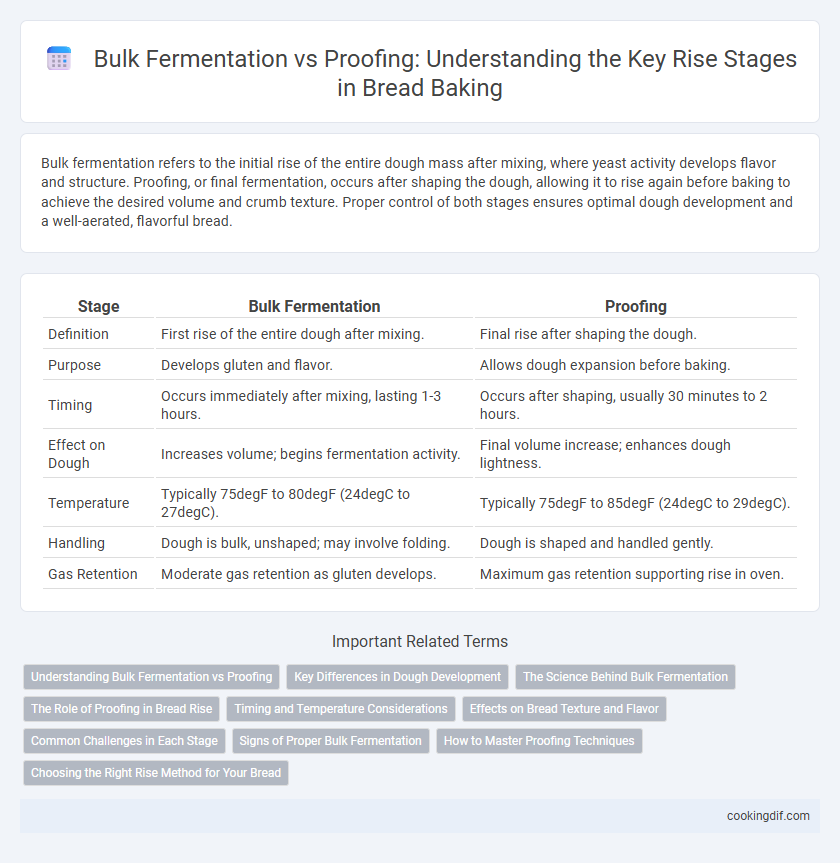Bulk fermentation refers to the initial rise of the entire dough mass after mixing, where yeast activity develops flavor and structure. Proofing, or final fermentation, occurs after shaping the dough, allowing it to rise again before baking to achieve the desired volume and crumb texture. Proper control of both stages ensures optimal dough development and a well-aerated, flavorful bread.
Table of Comparison
| Stage | Bulk Fermentation | Proofing |
|---|---|---|
| Definition | First rise of the entire dough after mixing. | Final rise after shaping the dough. |
| Purpose | Develops gluten and flavor. | Allows dough expansion before baking. |
| Timing | Occurs immediately after mixing, lasting 1-3 hours. | Occurs after shaping, usually 30 minutes to 2 hours. |
| Effect on Dough | Increases volume; begins fermentation activity. | Final volume increase; enhances dough lightness. |
| Temperature | Typically 75degF to 80degF (24degC to 27degC). | Typically 75degF to 85degF (24degC to 29degC). |
| Handling | Dough is bulk, unshaped; may involve folding. | Dough is shaped and handled gently. |
| Gas Retention | Moderate gas retention as gluten develops. | Maximum gas retention supporting rise in oven. |
Understanding Bulk Fermentation vs Proofing
Bulk fermentation involves allowing the entire dough mass to ferment after mixing, promoting gluten development and flavor enhancement through yeast activity. Proofing, or final fermentation, occurs after shaping the dough, focusing primarily on the expansion of gases within the dough to achieve the desired rise and volume before baking. Understanding the distinctions between bulk fermentation and proofing is crucial for optimizing texture, crumb structure, and flavor in artisanal bread baking.
Key Differences in Dough Development
Bulk fermentation is the initial rise stage where the entire dough mass ferments, allowing yeast activity to develop flavor and gluten structure uniformly. Proofing, also called the final rise, occurs after shaping the dough, focusing on volume increase and surface tension for optimal oven spring. Bulk fermentation emphasizes dough strength and gas retention, while proofing fine-tunes texture and prepares the dough for baking.
The Science Behind Bulk Fermentation
Bulk fermentation, also known as the first rise, is the stage where yeast metabolizes sugars, producing carbon dioxide and alcohol, causing the dough to expand and develop flavor complexity. During this phase, gluten strands strengthen, creating a cohesive network essential for trapping gases and achieving optimal dough structure. Understanding yeast activity, temperature, and time during bulk fermentation is critical for controlling dough texture and final bread quality.
The Role of Proofing in Bread Rise
Proofing, also known as the final fermentation, is crucial for bread rise as it allows the dough to develop gas bubbles created by yeast, resulting in a light and airy texture. During proofing, enzymes break down starches and proteins, enhancing flavor and crumb structure. Unlike bulk fermentation, which develops gluten and overall dough strength, proofing primarily focuses on volume expansion and final dough maturation before baking.
Timing and Temperature Considerations
Bulk fermentation typically occurs at 75-80degF for 1 to 3 hours, allowing yeast to produce gas and develop flavor before shaping. Proofing happens after shaping, usually at a slightly warmer 80-85degF for 45 minutes to 1.5 hours, optimizing dough rise right before baking. Proper timing and temperature control during both stages ensure ideal yeast activity and dough structure for optimal bread texture.
Effects on Bread Texture and Flavor
Bulk fermentation allows yeast to develop flavor and gas throughout the entire dough mass, resulting in a complex crumb structure and enhanced taste due to extended enzymatic activity. Proofing, which occurs after shaping, fine-tunes the dough's final rise, influencing the bread's surface texture and oven spring without significantly altering flavor complexity. Together, these stages optimize gas retention and gluten development, crucial for achieving a balanced texture and rich, nuanced aroma in the finished loaf.
Common Challenges in Each Stage
Bulk fermentation often faces challenges such as uneven gas production and inconsistent dough temperature, which can lead to poor gluten development and irregular crumb structure. Proofing commonly encounters difficulties like over-proofing or under-proofing, resulting in either a collapsed loaf or insufficient rise, affecting texture and volume. Both stages require precise control of time, temperature, and humidity to achieve optimal dough expansion and bread quality.
Signs of Proper Bulk Fermentation
During bulk fermentation, proper signs include a noticeable increase in dough volume by about 50-100%, a bubbly and slightly domed surface indicating active yeast fermentation, and a softer, more elastic texture when gently pressed. The dough should hold an indentation without quickly springing back, demonstrating adequate gluten development and gas retention. These indicators ensure the dough has properly matured before shaping and proofing.
How to Master Proofing Techniques
Mastering proofing techniques involves closely monitoring dough temperature and humidity to optimize yeast activity and gluten development during the final rise. Unlike bulk fermentation, proofing requires delicate handling to prevent overproofing, which leads to deflated loaves, by checking dough elasticity and the "poke test" for readiness. Consistent practice with controlled conditions enhances crumb structure and oven spring, yielding perfectly risen bread.
Choosing the Right Rise Method for Your Bread
Bulk fermentation develops gluten structure and flavor by allowing the entire dough mass to rise before shaping, ideal for rustic and artisan breads. Proofing occurs after shaping to create a final rise, controlling loaf volume and crumb texture for delicate, uniform results. Selecting bulk fermentation enhances depth and chewiness, while proofing ensures precise shape and fine crumb, making method choice crucial based on desired bread characteristics.
Bulk fermentation vs Proofing for rise stage Infographic

 cookingdif.com
cookingdif.com